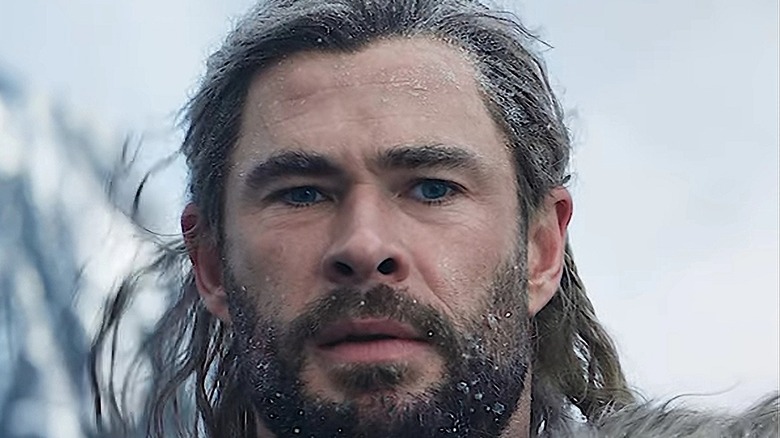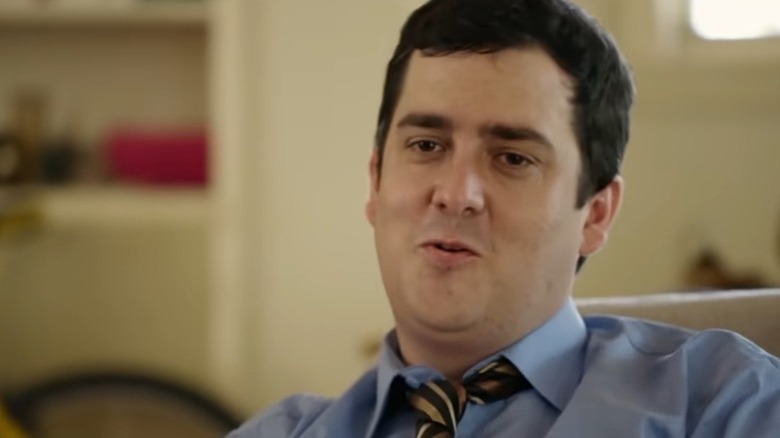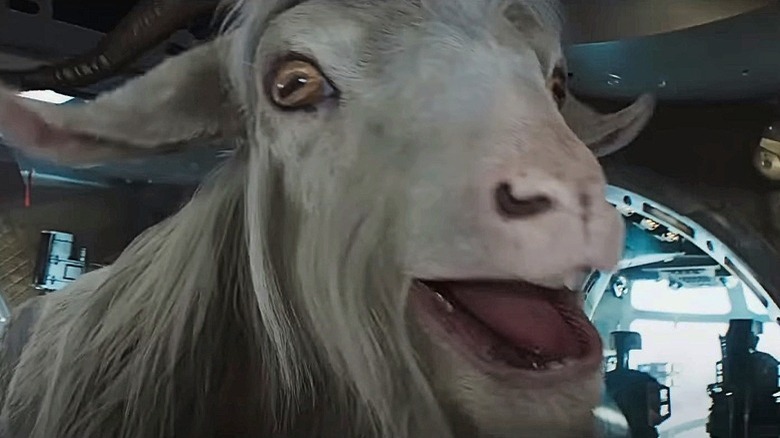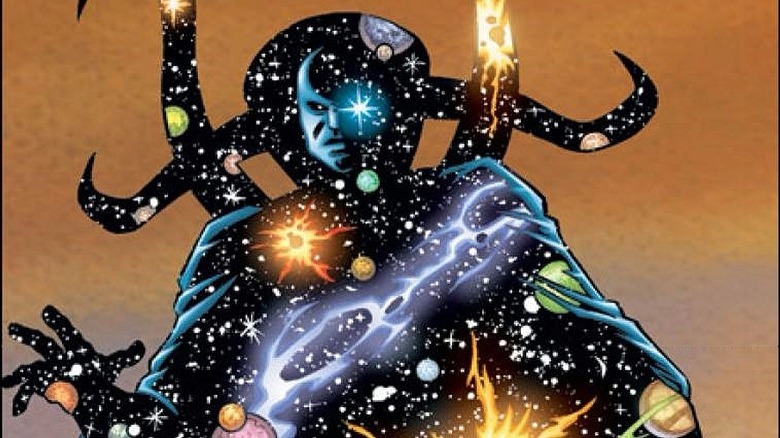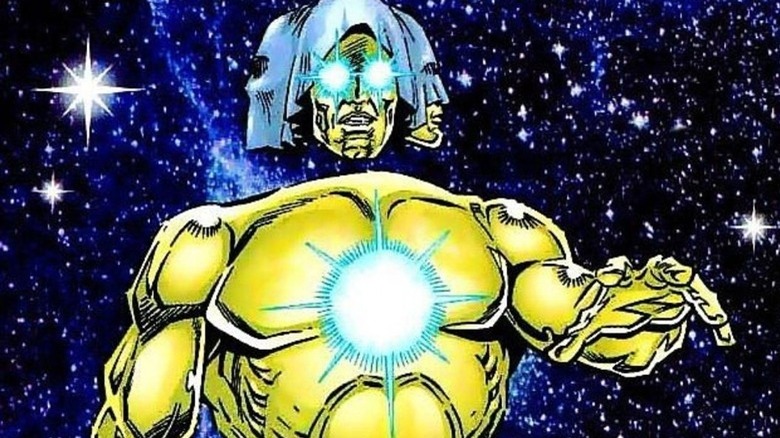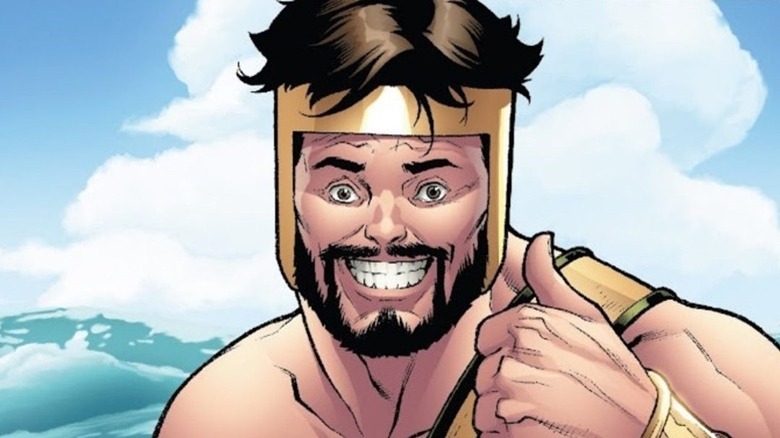Characters In Thor: Love And Thunder Who Mean More Than You Realized
The films of the Marvel Cinematic Universe tend to be able to be enjoyed on multiple different levels. Some watch them individually just for their thrills and spectacles. Others embrace their serialized nature and delight in how the most recent films call back to previous movies and set up future installments. Finally, others still dig in deep to find not only the connections to other films in the MCU, but references to the source material.
In the case of "Thor: Love and Thunder," there's plenty to delight any of the aforementioned groups. With its intense villain Gorr (Christian Bale) and the spooky powers he brings to the proceedings, fans who love a good villain will be pleased to watch him go toe to toe with Thor (Chris Hemsworth), The Mighty Thor (Natalie Portman), Valkyrie (Tessa Thompson), and Korg (Taika Waititi). Viewers who prefer laughs and exciting set pieces, on the other hand, will find plenty to enjoy in the film's non-stop jokes and impressive visuals.
If, however, you are someone who enjoys the deep dive, this article will serve you well. Read on to find out what tales lie under the surface of the characters of "Thor: Love and Thunder."
Darryl
You may or may not recognize New Asgard's chief tour guide, but Thor definitely should have. The tour guide, Darryl Jacobson (Daley Pearson), was Thor's roommate as he relaxed in Australia while the MCU was going through its "Civil War" phase. Throughout two shorts — "Team Thor" and "Team Thor: Part 2" — Darryl did his best to explain life on Earth to the god, including concepts like human money and gainful employment.
After Thor left Australia to become reinvolved in superhero matters, Darryl took the opportunity to make some changes himself. He moved to Los Angeles and got a new roommate, the Grandmaster (Jeff Goldblum). Unfortunately, the former ruler of Skaar was as ignorant of human behaviors and concerns as Thor and somehow even more entitled. While Darryl did his best to explain things to Grandmaster, as he did with the God of Thunder, he mostly tried to avoid being melted and keep the temperamental housemate's disquieting interest in him at arm's length.
The Goats
Thor's goats, a dubious gift from an alien world that has ... mixed feelings about Thor's intervention in their affairs, may seem like a throwaway joke in "Thor: Love and Thunder." But fans of Norse mythology may recognize them as a different interpretation of Tanngrisnir and Tanngnjóstr, the so-called war goats of Thor. An early joke in the film hints at their mythological roots. Thor briefly mentions that he and the Guardians could use the goats for meat if they get too annoying. In Norse mythology, Thor would slay, cook, and eat the goats on long journeys, only to awake the following day with the goats reborn and ready to pull his chariot again.
In Marvel Comics, the goats are known as Toothgnasher and Toothgrinder. Intended as an instrument of humiliation by Loki, he convinced Thor that anyone could use horses, but only someone truly amazing could bridle the two goats. When Thor pulled it off and arrived in Asgard, laughter and derision met him. A point to Loki.
Still, as is par for the course in the Thor-Loki rivalry, the whole escapade eventually ended up a win for Thor. He stuck with his goats, and they proved incredibly loyal. In fact, when Thor was briefly turned into a frog, the only allies he could count on were the goats, who recognized him as a green-skinned amphibian as easily as they did a tall, blonde Viking.
Eternity
In the Marvel Universe, several abstract concepts — such as Death and Empathy — are given physical form. Eternity is one such concept turned living being. And while his look in "Thor: Love and Thunder" is very close to his comic book counterpart, his role is considerably different.
The Eternity of the comics is not a sort of mystical wishing genie in the center of the universe. Instead, he is the physical embodiment of the entire mainstream Marvel Universe, the so-called 616. Every universe within the Multiverse is encompassed by another Eternity figure. Nearly omnipotent, Eternity rarely makes himself known. However, at times of great danger to the galaxy, including when Thanos attempted to eliminate all life, he is known to appear.
Eternity can also have relationships, despite being the physical representation of all life throughout the universe. He has a sister named Infinity (who also seems to be present as a statue in the Gateway to Eternity). He has been known to fall in love, including with the DC Comics character Kismet in Avengers/JLA. Unfortunately, their passion endangered the survival of both of their universes, and they were forced to break it off for the good of all existence.
While he and Infinity are equal in sheer cosmic power, neither is the most powerful being in existence. That honor goes to the Living Tribunal.
The Living Tribunal
While this powerful cosmic being never actually appears in "Thor: Love and Thunder," a statue depicting the Living Tribunal can be seen in the setting of Gorr's last stand, the Gateway to Eternity. Eagle-eyed viewers may also recall appearances by the Tribunal in "Loki" and "Doctor Strange In the Multiverse of Madness." Said to be a being encompassing the entirety of multiversal law, the Tribunal is the ultimate authority of all existence, although he does seemingly answer to a never-seen entity called the One Above All.
While the Tribunal is vastly powerful, his only mission is to keep the Multiverse in balance. He will rarely intercede in the day-to-day events of human — or any other living being for that matter — existence. When he does, it may not always be for what most would consider "good." This is because he only seeks balance. He must "fix" things if the Multiverse grows too "good," just as he must if it grows too "evil." For instance, he once stepped in to tell Adam Warlock that he could not be allowed to possess the Infinity Stones all by himself, as that much power would inevitably lead to corruption. However, he also rejected Eternity's request that he be given the Stones, as that choice would lead to excessive order in the Multiverse.
In a universe full of strange beings with confusing motivations, the Living Tribunal truly moves in the most mysterious of ways.
Hercules
Yes, most of us are familiar with the demigod of Greek and Roman myth, Hercules. However, the Marvel version of Hercules, much like Thor, is considerably more than his mythology.
First officially appearing in "Journey Into Mystery" Annual #1 in 1965, Marvel's Hercules quickly established himself as a rival to the God of Thunder. (This seems to be how the MCU is set to use him, if his mid-credits debut, played by Brett Goldstein, is any indication.) Less than a year later, however, he became a regular supporting player in "The Mighty Thor" series. A year after that, Hercules became officially recognized as a full-fledged Avenger.
Hercules' depiction has evolved with time. Initially depicted as quick-tempered and not especially intelligent, he has grown into a three-dimensional character capable of great empathy. His long-term team-up with Amadeus Cho best exemplified this in the pages of "Incredible Hercules."
The longer Hercules has been a part of the Marvel Universe, the more the focus has shifted away from his temper to his other dominant emotional state — being in love. Or in lust, at least. Hercules has boasted many a relationship over the years, including with fellow heroes like Snowbird, Black Widow, and Marvel Boy.
